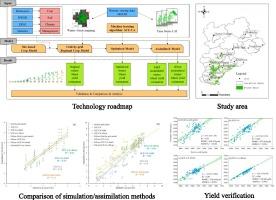将遥感同化与 SCE-UA 相结合,构建逐格空间化作物模型,可显著提高冬小麦产量估算的准确性
IF 7.7
1区 农林科学
Q1 AGRICULTURE, MULTIDISCIPLINARY
引用次数: 0
摘要
谷物产量估算仍然是农业研究的一个焦点。众所周知,作物模型在田间应用中具有极高的准确性,但由于输入参数要求严格、数据获取困难以及参数校准复杂,其在区域层面的可扩展性遇到了巨大的限制。为了克服上述挑战,本研究试图建立一个空间化的作物生长模型,该模型以网格为单位,由包括各种遥感和统计输入在内的大量数据源推动。我们的方法包括将机器学习技术--洗牌复杂进化算法(SCE-UA)与两种遥感同化方法(四维变异同化算法(4Dvar)和集合卡尔曼滤波器(Enkf))相结合,提出一种用于模型校准的自动参数优化方法,以优化模型轨迹,提高作物产量估算的准确性。这一创新方法解决了与区域尺度模拟相关的复杂问题,弥补了传统作物模型固有局限性与高精度产量估算需求之间的差距。结果表明(1) 我们提高了区域作物模型的精确度,决定系数(R2)从 0.53 提高到 0.94,均方根产量从 824.82 千克/公顷提高到 148.48 千克/公顷。48 kg/ha,大大提高了冬小麦估产精度;(2)在比较了不同的优化和同化策略后,复杂洗牌算法(SCE-UA)结合四维变分算法(4Dvar)的模拟策略可以使逐格模型估产达到最高的模拟精度,R2 为 0.94,均方根误差(RMSE)为 148.48 千克/公顷;(3)我们评估了算法的模拟效果,并讨论了逐格模型的缺点和不确定性。这项研究对于开发用于估算冬小麦产量的空间化模型以及提高我们在粮食生产和农业管理领域的知情决策能力具有重要的现实意义。本文章由计算机程序翻译,如有差异,请以英文原文为准。

Integrating remote sensing assimilation and SCE-UA to construct a grid-by-grid spatialized crop model can dramatically improve winter wheat yield estimate accuracy
Grain yield estimation remains a focal point in agricultural research. It’s well known that crop models have very high accuracy in field application, but their scalability to a regional level encounters formidable constraints attributed to stringent input parameter demands, challenges in data acquisition, and complexities in parameter calibration. In a concerted effort to overcome these aforementioned challenges, this study endevours to formulate a spatialized crop growth model, organized grid by grid, propelled by a myriad of data sources encompassing diverse remote sensing and statistical inputs. Our approach involves the integration of a machine learning technique—the shuffled complex evolution algorithm (SCE-UA) to propose an automatic parameter optimization method for model calibration, alongside two remote sensing assimilation methods: a four-dimensional variational assimilation algorithm (4Dvar) and ensemble Kalman filter (Enkf) to optimising model trajectories to improve crop yield estimation accuracy. This innovative methodology addresses the intricacies associated with regional-scale simulation and bridges the gap between the inherent limitations of conventional crop models and the demand for high-precision yield estimations. The results show that: (1) we improved the accuracy of the regional crop model from 0.53 to 0.94 for the coefficient of determination (R2) and from 824.82 kg/ha to 148.48 kg/ha for root mean square error (RMSE), which greatly improved the accuracy of winter wheat yield estimation; (2) after comparing different optimization and assimilation strategies, the simulation strategy of complex shuffling algorithm (SCE-UA) combined with the four-dimensional variational algorithm (4Dvar) can enable the grid-by-grid model to estimate yield to achieve the highest simulation accuracy, with R2 of 0.94 and RMSE of 148.48 kg/ha; (3) we evaluated the simulation effectiveness of the algorithm and discuss the shortcomings and uncertainties of the grid-by-grid model. This study has important practical implications for the development of spatialized models for estimating winter wheat yields and bolstering our capacity for informed decision-making in the realm of food production and agricultural management.
求助全文
通过发布文献求助,成功后即可免费获取论文全文。
去求助
来源期刊

Computers and Electronics in Agriculture
工程技术-计算机:跨学科应用
CiteScore
15.30
自引率
14.50%
发文量
800
审稿时长
62 days
期刊介绍:
Computers and Electronics in Agriculture provides international coverage of advancements in computer hardware, software, electronic instrumentation, and control systems applied to agricultural challenges. Encompassing agronomy, horticulture, forestry, aquaculture, and animal farming, the journal publishes original papers, reviews, and applications notes. It explores the use of computers and electronics in plant or animal agricultural production, covering topics like agricultural soils, water, pests, controlled environments, and waste. The scope extends to on-farm post-harvest operations and relevant technologies, including artificial intelligence, sensors, machine vision, robotics, networking, and simulation modeling. Its companion journal, Smart Agricultural Technology, continues the focus on smart applications in production agriculture.
 求助内容:
求助内容: 应助结果提醒方式:
应助结果提醒方式:


